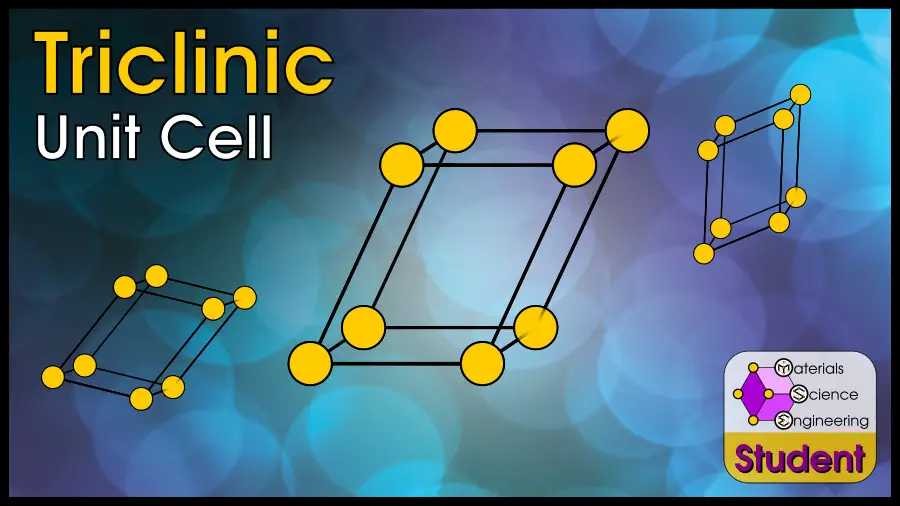
The triclinic Bravais lattice is the most general Bravais lattice, with no symmetry requirements. For this reason, it is sometimes called the “asymmetric” lattice or crystal structure. Triclinic has 3 unequal lattice parameters a, b, and c; and 3 different, non-90º lattice angles α, β, and γ.
The simple triclinic crystal structure is based on the triclinic Bravais lattice, with 1 atom per unit cell, coordination number CN=2, and atomic packing factor .
Since simple triclinic is one of the less-common crystal structures, I’m assuming someone searching for this is a somewhat advanced student in materials science, so I’ll give you the facts quickly and with little explanation. IIf you are new to materials science and don’t know what something means, you can check out my articles on the FCC, BCC, or HCP crystals, which explain terminology more slowly.
Although there are many crystal structures that fit with “triclinic” symmetry, the simple triclinic crystal structure has exactly 1 atom per lattice point in the triclinic Bravais lattice.
As far as I know, there are no real-world materials that exhibit a simple triclinic unit cell. There are “triclinic” crystals based on the Bravais lattice, which exist with multiple atoms that overall displays triclinic symmetry. The simple triclinic unit cell would belong to space group #2 or P-1, with Pearson symbol aP1. There is no prototype or Strukturbericht for simple triclinic, since it does not exist with real atoms.
Outline
Common Examples of Triclinic Materials
None.
However, there are still materials made of multiple kinds of atoms (or a multi-atom basis) that have a triclinic Bravais lattice, such as Cf, P2I4, and FeS2.
Triclinic Coordination Number
The simple triclinic crystal has the lowest symmetry possible, so there are just 2 nearest-neighbors along the shortest lattice vector.
Simple triclinic has CN=2; however, there are no real materials that take this crystal structure.
Triclinic Lattice Constants
The triclinic system has 6 independent lattice parameters: vector lengths a, b, and c; and vector angles α, β, and γ.
If you wanted to describe the simple triclinic crystal with math, you would describe the cell with the primitive vectors.
where
Triclinic Atomic Packing Factor
There is no simple answer for the simple triclinic APF, because the answer changes depending on the side lengths and angles
The volume of an triclinic unit cell is , where
.
There is 1 atom split between each of the 8 corners of the cell, and nothing in the center, so the total is one full atom with a spherical radius of .
This allows us to write the theoretical APF in terms of the atomic radius and lattice constants.
Final Thoughts
The simple triclinic crystal system does NOT exist in real life, and only arises by mathematical definition. There are many crystals which have a triclinic Bravais lattice, but these crystals have a more complicated “basis” which leads to its characteristic asymmetrical lattice parameters.
References and Further Reading
If you want to know more about the basics of crystallography, check out this article.
If you weren’t sure about the difference between crystal structure and Bravais lattice, check out this article.
I also mentioned atomic packing factor (APF) earlier in this article. This is an important concept in your introductory materials science class, so if you want a full explanation of APF, check out this page.
If you’re interested in advanced crystallography or crystallography databases, you may want to check out the AFLOW crystallographic library.
For a great reference for all crystal structures, check out “The AFLOW Library of Crystallographic Prototypes.”
The 14 Basic Crystal Structures
If you want to learn about specific crystal structures, here is a list of my articles about Bravais lattices and some related crystal structures for pure elements. Simple Triclinic is one of these 14 Bravais lattices and also occurs as a crystal structure.
1. Simple Cubic
2. Face-Centered Cubic
2a. Diamond Cubic
3. Body-Centered Cubic
4. Simple Hexagonal
4a. Hexagonal Close-Packed
4b. Double Hexagonal Close-Packed (La-type)
5. Rhombohedral
5a. Rhombohedral Close-Packed (Sm-type)
6. Simple Tetragonal
7. Body-Centered Tetragonal
7a. Diamond Tetragonal (White Tin)
8. Simple Orthorhombic
9. Base-Centered Orthorhombic
10. Face-Centered Orthorhombic
11. Body-Centered Orthorhombic
12. Simple Monoclinic
13. Base-Centered Monoclinic
14. Triclinic
Other articles in my crystallography series include:
Introduction to Bravais Lattices
What is the Difference Between “Crystal Structure” and “Bravais Lattice”
Atomic Packing Factor
How to Read Miller Indices
How to Read Hexagonal Miller-Bravais Indices
Close-Packed Crystals and Stacking Order
Interstitial Sites
Primitive Cells
How to Read Crystallography Notation
What are Point Groups
List of Point Groups
What are Space Groups
List of Space Groups
The 7 Crystal Systems